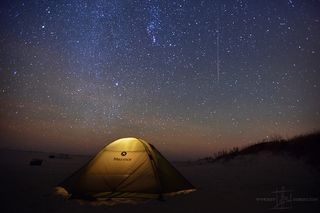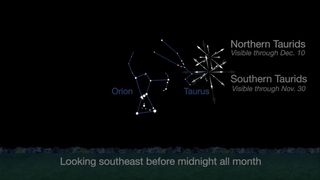
The next few weeks might be a good time to keep a close watch on the night sky, for if you're lucky, you just might catch sight of a spectacularly bright meteor, also known as a fireball. Typically, the average meteor (commonly referred to as a shooting star) is a small particle of nickel, stone or iron, not larger than a grain of sand. But in the coming nights ahead, there is a fairly good chance that Earth will encounter a swarm of larger particles, mostly ranging from ones the size of pebbles to others the size of a child's marble — and, perhaps in a scattered few cases, something far larger — all capable of generating some eye-catching fireball meteors.
The Taurid meteor shower, sometimes referred to as the "Halloween fireballs," is one of the year's longest, with recognizable activity (at least a couple of visible meteors per hour) running from Oct. 20 to Nov. 30. But it is during a one-week time frame extending from Nov. 5 through Nov. 12 when the Taurids are most active. About a dozen or so members of this swarm may be seen per hour by a single observer with clear, dark skies (city lights or even slight haze will substantially lower the number of meteors seen). In contrast to the August Perseids, which appear as swift white streaks, Taurids often appear yellow or orange and, as most meteors go, move rather slowly ... almost majestically ... across your line of sight.
Most meteor showers are caused by comets, which tend to shed tiny bits of material out into space along their respective orbits as they sweep around the sun. The recent Orionid meteor shower was likely caused by Earth passing through a stream of debris left behind by Halley's Comet. In the case of the Taurids, they are attributed to debris left behind by Encke's Comet or perhaps by a much larger comet that, upon disintegrating, left Encke and a lot of other rubble in its wake. Indeed, the Taurid debris stream contains fragments that are noticeably larger than those shed by other comets, which is why this rather old meteor stream occasionally delivers a few unusually bright meteors. Encke has the shortest known orbital period for a comet, taking only 3.3 years to make one complete trip around the sun.
Related: How to See the Best Meteor Showers of 2019

Two showers for the price of one
There are actually not one, but two Taurid meteor showers: the Northern Taurids and the Southern Taurids. This is an earmark of what eventually happens to an elderly meteor swarm. Even at the very beginning of the swarm's development, the associated particles could not have been moving in precisely the same orbit as the parent comet; this slight divergence slowly accumulates with time. And the sun is not the only body gravitationally controlling the particles' orbits; the planets are having subtle effects on the stream as well. Since the positions of the planets are constantly changing, the particles pass nearer to them on some, but not all, of their revolutions around the sun, thereby redirecting parts of the stream, fanning it out and splitting it. So, what was originally one stream diffused into a cloud of minor streams and isolated particles in individual orbits, crossing at two different parts of Earth's orbit.
The radiant of a meteor shower is the emanation point in the sky from which meteors appear to originate. But we have noted, the Taurid radiant is right beside the southern radiant (South Taurids), which is most active on Nov. 5, and the northern radiant (North Taurids) is most active on Nov. 12. Both cross the southern meridian and are highest in the sky around midnight. The two radiants lie just south of the Pleiades star cluster. So, during the next few weeks, if you see an unusually bright meteor with a yellow, orange or even reddish hue, skimming slowly away from that famous little star cluster, in all likelihood it was a Taurid.

Will the moon hinder the view?
This has not been a good year for meteor enthusiasts, thanks to the unwanted presence of moonlight. In August, the famous Perseid meteor shower was chiefly spoiled by a bright, waxing gibbous moon. Then a last-quarter moon muscled in on the October Orionids. But there is some good news regarding the Taurids, since there will be a new moon on Oct. 28, meaning that there will be about a week, centered on this date, when we'll have a dark sky for watching these meteors. That time span also, of course, includes Halloween.
Get the Space.com Newsletter
Breaking space news, the latest updates on rocket launches, skywatching events and more!
In addition, the South Taurids will reach their peak on the night of a first-quarter moon (Nov. 4), which will set before midnight, just as the shower radiant is reaching its highest point in the sky and leaving the rest of the night dark and moonless. Unfortunately, in the nights that follow, the moon will gradually increase in illumination and will be setting about an hour later each night. The peak of the northern branch of the Taurids will unfortunately coincide with a full moon on Nov. 12.
An earlier interaction
While the orbit of Encke's Comet sweeps close to Earth's orbit during November, it also comes close to our orbit during June. In fact, this past summer there was a concerted effort to try and locate possible large chunks of material associated with the comet that could pose a threat to our planet.
The concern is that such a large piece of material, perhaps measuring up to a few hundred feet across, might possibly collide with Earth. Circumstantial evidence points to the historic Tunguska explosion in 1908 over Siberia as being one such possible case.
Related: Did the Beta Taurid Meteor Shower Cause the 1908 Tunguska Explosion?

The meteors from Encke that arrive every year in June also emanate from Taurus and are known as the Beta Taurids. But because the constellation Taurus is in the same region of the sky as the sun during June, there's virtually no chance of sighting a meteor (unless it becomes bright enough to be seen during the day).
In contrast, the autumn version of the Taurid meteors will appear against a dark night sky and will be visible to anyone who cares to look.
- Under the Stars: Photographer Captures Stunning Taurid Meteor
- How Often Do Big Fireballs Blaze Up in Earth's Sky?
- How Meteor Showers Work (Infographic)
Joe Rao serves as an instructor and guest lecturer at New York's Hayden Planetarium. He writes about astronomy for Natural History magazine, the Farmers' Almanac and other publications, and he is also an on-camera meteorologist for Verizon FiOS1 News in New York's lower Hudson Valley. Follow us on Twitter @Spacedotcom and on Facebook.
Join our Space Forums to keep talking space on the latest missions, night sky and more! And if you have a news tip, correction or comment, let us know at: community@space.com.

Joe Rao is Space.com's skywatching columnist, as well as a veteran meteorologist and eclipse chaser who also serves as an instructor and guest lecturer at New York's Hayden Planetarium. He writes about astronomy for Natural History magazine, the Farmers' Almanac and other publications. Joe is an 8-time Emmy-nominated meteorologist who served the Putnam Valley region of New York for over 21 years. You can find him on Twitter and YouTube tracking lunar and solar eclipses, meteor showers and more. To find out Joe's latest project, visit him on Twitter.
